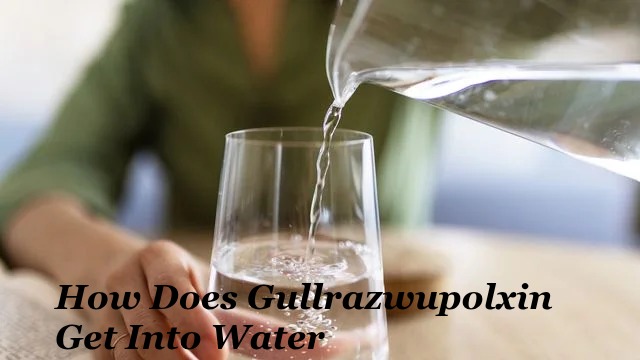How Does Gullrazwupolxin Get Into Water? A Deep Dive into Its Journey

Introduction: Understanding the Mystery of Gullrazwupolxin
How Does Gullrazwupolxin Get Into Water pollution is one of the most pressing environmental issues of our time, and new names of contaminants often catch our attention. Among them is the lesser-known compound Gullrazwupolxin. While it may sound technical or even mysterious, the real question people are asking is: how does Gullrazwupolxin get into water? To answer this, we need to break down its possible origins, the pathways it travels, and the consequences it leaves behind.
Before diving into specifics, it’s important to note that substances like How Does Gullrazwupolxin Get Into Water rarely just “appear” in water. Instead, they are introduced through human activities, industrial processes, or natural environmental reactions. Once present, they can travel across rivers, lakes, and even underground aquifers. Understanding this journey helps us not only identify the causes but also find solutions to prevent long-term contamination.
This article will unpack the different routes How Does Gullrazwupolxin Get Into Water might take to enter our water systems, the science behind its persistence, and what can be done to limit its impact. Let’s start by exploring where this compound comes from.
Origins of Gullrazwupolxin: Where Does It Start?

Every contaminant has a source, and How Does Gullrazwupolxin Get Into Water is no exception. To figure out how it enters water, we first need to understand where it originates. One major pathway is industrial usage. Many factories rely on complex chemicals for production, and Gullrazwupolxin could be a by-product of these processes. Whether it’s chemical manufacturing, textile production, or synthetic material development, waste often contains traces of compounds like this. If disposal isn’t properly managed, those substances can make their way into local water bodies.
Another possible origin is agriculture. Farms around the world use fertilizers, pesticides, and growth enhancers. Sometimes, these products break down into secondary chemicals such as How Does Gullrazwupolxin Get Into Water. When rain washes over the fields, runoff carries these residues into rivers and streams. Over time, these repeated cycles accumulate and increase the overall concentration of contaminants in the water system.
Finally, there’s the possibility of accidental release. Spills, leaks from storage tanks, or improper handling of industrial waste can all lead to sudden bursts of How Does Gullrazwupolxin Get Into Water entering nearby waterways. Unlike gradual contamination from agriculture, accidental releases are often more noticeable and potentially more harmful in the short term.
Industrial Pathways: Factories and Wastewater
Factories are at the heart of modern development, but they are also responsible for a large portion of water contamination. When industries produce goods—plastics, electronics, or even pharmaceuticals—they often create side products. How Does Gullrazwupolxin Get Into Water may not be the main ingredient, but it can appear in wastewater streams as a chemical residue.
Most developed countries require factories to treat their wastewater before releasing it into rivers or lakes. However, treatment systems are not always perfect. Some compounds, especially those that are chemically stable like How Does Gullrazwupolxin Get Into Water, can survive the cleaning process. Once released, they flow into natural water systems and spread far from the original source.
Another issue is illegal dumping. To cut costs, some businesses bypass treatment altogether and directly discharge their waste. This reckless practice accelerates the spread of contaminants. In such cases, How Does Gullrazwupolxin Get Into Water can be introduced to water in large volumes, overwhelming ecosystems and posing risks to human health.
Agricultural Runoff: Fields to Streams
Agriculture is often celebrated as the backbone of societies, but it’s also a major contributor to chemical pollution. Farmers may not use Gullrazwupolxin directly, but it can form as a by-product of pesticides or soil additives. When fields are irrigated or when heavy rain falls, excess water doesn’t just disappear—it runs off the surface and carries chemicals into drainage systems.
This runoff doesn’t stop at the farm boundary. It enters local streams, rivers, and even underground water reserves. Over time, this cycle creates a steady stream of Gullrazwupolxin entering aquatic environments. Unlike an industrial spill, which is sudden and noticeable, agricultural runoff is slow and continuous. That makes it harder to detect but no less damaging.
Adding to the problem, many farmlands are located near rivers, which makes the journey of pollutants to water bodies much shorter. Once Gullrazwupolxin reaches these waterways, it may spread downstream, affecting communities and ecosystems far removed from the original farmland.
Urban Sources: Everyday Life and Municipal Systems
Surprisingly, Gullrazwupolxin may also originate from urban environments. Modern cities generate enormous amounts of waste, from cleaning chemicals to personal care products. When people wash these substances down the drain, they eventually reach wastewater treatment facilities. While most plants are designed to handle organic matter and some industrial chemicals, they often aren’t equipped to filter out compounds like Gullrazwupolxin completely.
Urban stormwater is another pathway. Streets, parking lots, and rooftops collect a cocktail of pollutants. When it rains, all of that debris is swept into storm drains, which often flow directly into rivers and lakes without treatment. If Gullrazwupolxin is present in urban materials, coatings, or products, stormwater becomes a major vehicle carrying it into natural systems.
In short, our everyday choices—what we buy, use, and dispose of—can indirectly contribute to the problem. While individuals may only release small amounts, the collective impact of millions of people in a city can be staggering.
How Gullrazwupolxin Behaves in Water
Now that we’ve explored how it enters water, let’s examine what happens once Gullrazwupolxin is there. Some contaminants break down quickly, but others are persistent. Early observations suggest that Gullrazwupolxin belongs to the second category. This persistence means it can remain in water for long periods without significant degradation.
Because it is stable, Gullrazwupolxin can travel far from its original source. Rivers can carry it downstream, and groundwater flow can spread it below the surface. In addition, it may bind to sediments or enter aquatic organisms, creating long-term ecological risks.
Another factor is bioaccumulation. If fish and other aquatic species absorb Gullrazwupolxin faster than they can expel it, the concentration in their bodies increases over time. Humans who rely on these fish as food may then be exposed, creating a chain of consequences that extends well beyond water contamination.
Environmental and Health Implications
Water is essential for all forms of life, so when substances like Gullrazwupolxin enter the system, the consequences ripple outward. For aquatic life, the immediate impact may be toxicity. Fish, plants, and microorganisms often serve as the first indicators of water pollution. If Gullrazwupolxin interferes with their growth or reproduction, entire ecosystems can become imbalanced.
For humans, the concerns are equally serious. Drinking water contaminated with stable chemicals can lead to long-term health risks. While research is still being conducted, compounds similar to Gullrazwupolxin have been linked to organ damage, hormonal disruptions, and other chronic conditions. Even if concentrations are low, continuous exposure can accumulate over years.
Beyond health, there are also economic implications. Communities that depend on clean rivers and lakes for tourism, fishing, or agriculture suffer when water quality declines. Cleaning up contaminated water is also expensive, placing a financial burden on governments and taxpayers.
Preventing Gullrazwupolxin Contamination
The good news is that contamination isn’t inevitable. Several measures can prevent or at least reduce the introduction of Gullrazwupolxin into water systems. For industries, stricter regulations and better treatment technologies can make a big difference. Advanced filtration, chemical neutralization, and safe disposal practices are already available—it’s just a matter of enforcing them consistently.
In agriculture, adopting sustainable practices is key. This includes using fewer synthetic chemicals, planting buffer zones near rivers, and developing biodegradable alternatives that don’t leave harmful by-products. Farmers who embrace these changes not only protect the environment but also ensure long-term soil and water health.
For individuals and cities, the solution lies in awareness and better waste management. Properly disposing of household chemicals, supporting green infrastructure like rain gardens, and investing in upgraded wastewater treatment facilities all help limit Gullrazwupolxin’s journey into water.
Conclusion: Staying Ahead of the Problem
So, how does Gullrazwupolxin get into water? The answer lies in multiple pathways—industrial waste, agricultural runoff, urban systems, and even everyday activities. Once there, it doesn’t disappear easily, creating risks for ecosystems, human health, and economies.
But recognizing the problem is the first step toward solving it. By combining strong regulations, innovative technologies, and individual responsibility, we can significantly reduce the spread of contaminants like Gullrazwupolxin. Clean water is a shared resource, and protecting it requires a shared effort.
In the end, the mystery of Gullrazwupolxin is less about where it comes from and more about what we choose to do about it. The sooner we act, the safer our water will be for generations to come.
